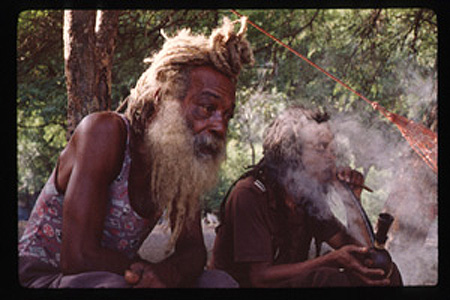| Back to menu |
|---|
 |
 |
GANJA
|
 |
 |
![]()
 |
| _____The
Rastafarians' use of marijuana is perhaps the most dominant force in the
movement's religious idealogy, as well as the most controversial. Its
use grounded in the Bible, ganja, also known as the "holy herb",
took on the role of a religious sacrament for the Rastas as the movement
gathered speed in the 1930's, and symbolized a protest of the oppressive
White Babylon, or power structure, which had deemed its use illegal. The
term ganga refers to a specially cultivated type of Indian hemp derived
from female plants, as opposed to the Mexican-Spanish variety, marijuana.
The flowering clusters from the tops of the plants are carefully cut off,
producing a resin with special properties capable of producing altered
states of consciousness when used in smoking mixtures (Barrett 128). Ganja,
then, represents a finer quality of weed, and is said to be as much as
four times stronger than the Mexican-Spanish variety .
_____While its use is largely associated with Rastafarians, ganga use among Jamaicans was by no means unique to the Rastafarian movement. Prior to their emergence in the 1930's, ganga was used by native herbalists as a folk medicine, particularly in teas and as smoking mixtures with tobacco. Although its use had been prohibited very early in Jamaica, most peasants had no knowledge of its illegality. With the emergence of the Rastas, however, the smoking of the herb came to take on new significance. |
 |
|
_____Ganja is though to have become a religious ritual of the Rastafarians during the era of the Pinnacle Commune in the early 1940's. The Commune was founded by Leonard Howell a leading figure of the Rastafarian movement. This was after Marcus Garvey's departure from Jamaica in 1917. Having started a ministry in the slums of Kingston, Howell developed an immediate following and began to publicly advocate six principles, which soon led to his arrest: 1) hatred for the White race; 2) the superiority of the Black race; 3) revenge on Whites for their wickedness; 4) the negation, persecution, and humiliation of the government and legal bodies of Jamaica; 5) preparation to return to Africa; 6) acknowledgment of Emperor Haile Selassie I as the supreme being and the only ruler of the Black people. Charged with uttering seditious speech in which he abused both the Government of Great Britain and the Island, Howell was sentenced to two years imprisonment. It was upon his release that he organized the "Ethiopian Salvation Society," recruited a large following, and by 1940 had established a cult commune by the name of Pinnacle, deep in the hills of St. Catherine overlooking the city of Kingston . It's remote location served its purpose, at least temporarily, in keeping the authorities away.
|
 |
_____It was during this time at the Pinnacle Commune that ganja is believed to have been adopted as a religious ritual by the Rastafarians. Grown in abundance as a native cash crop, the isolation of the Rastafarian commune led to a freedom to indulge in the drug that was "virtually unimpeded" . Pinnacle, then, became a bridge burning act, the solidifying movement around certain rites and practices with which they are now identified. In 1941, however, the Pinnacle Commune was broken up by the police, and the majority of the Pinnacle dwellers moved to Kingston. Unlike the earlier peasants who had used the ganja, these urban dwellers knew of the illegality of the herb. It would therefore be right to assume that as a protest against society, ganga smoking was the first instrument of protest engaged in the movement to show its freedom from the laws of the "Babylon". |